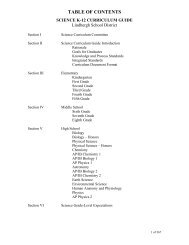test-taking tips you can use with your family. - Lindbergh School ...
test-taking tips you can use with your family. - Lindbergh School ...
test-taking tips you can use with your family. - Lindbergh School ...
Create successful ePaper yourself
Turn your PDF publications into a flip-book with our unique Google optimized e-Paper software.
Tip #5: Teach <strong>you</strong>r child that visuals are part of the text.<br />
Parents may teach children a broader view of the word “text.” On the MAP Communication Arts <strong>test</strong>, items<br />
sometimes require students to do more than just read the words in a passage. Students may need to gather<br />
information from photos, captions, drawings or charts and graphs. You <strong>can</strong> remind <strong>you</strong>r child to look at all of these<br />
materials as part of the total text.<br />
Tip #6: Help <strong>you</strong>r child know how to <strong>use</strong> text-based support in written responses.<br />
Most of the constructed-response items on the MAP Communication Arts <strong>test</strong> contain two parts. First, the student is<br />
asked a content question such as “What is the main idea of this passage?” or “Why is this an appropriate title for the<br />
story?” Second, the student is told to support his or her answers <strong>with</strong> detail and examples from the story. If students<br />
give answers to questions but do not support those answers adequately <strong>with</strong> specific details from the passage, they<br />
will receive only partial credit. This is the most common ca<strong>use</strong> for the loss of points on the <strong>test</strong>. You <strong>can</strong> improve<br />
<strong>you</strong>r child’s score simply by reiterating to <strong>you</strong>r child to <strong>use</strong> specific details from the story.<br />
Tip #7: Teach <strong>you</strong>r child to read the <strong>test</strong> questions first.<br />
While directions on most standardized communication arts <strong>test</strong>s, including the MAP Communication Arts <strong>test</strong>, tell<br />
students to read the passage first and then answer the questions that follow, classroom research has shown that many<br />
students do better if they read the items first, then return to read the passage (Calking 86-87). Reading the questions<br />
first gives students a purpose and direction for their reading. Reading in a <strong>test</strong>ing situation is clearly different than<br />
reading for pleasure. Emphasize to <strong>you</strong>r child that the purpose is to find answers to the specific questions being<br />
asked. Looking at the questions first simply makes more sense in a <strong>test</strong>ing situation.<br />
Tip #8: Help <strong>you</strong>r child find out how many <strong>test</strong> items they <strong>can</strong> hold in memory while reading a passage.<br />
Many elementary students will have trouble remembering more than two questions at a time. Even high school<br />
students probably will run into trouble if they try to remember more than four items at a time. Through practice,<br />
students <strong>can</strong> experiment until they find the best number for each of them individually to try to hold in mind while<br />
reading the <strong>test</strong>. Once students have identified their optimal number of questions to remember, they are ready to<br />
practice using <strong>tips</strong> #7 and #8 together.<br />
Tip #9: Teach <strong>you</strong>r child to identify all parts of a question.<br />
Another <strong>test</strong>-<strong>taking</strong> skill <strong>you</strong> <strong>can</strong> teach <strong>you</strong>r child is how to identify exactly what each question is asking. Some<br />
questions have multiple parts, and these parts are often combined into a single sentence <strong>with</strong> a single question mark<br />
at the end. Students should underline each question word (who, what, when, where, why, how, and any other word<br />
or phrase that indicates a question). By doing so, they <strong>can</strong> see if a question has multiple parts. Not answering all<br />
parts of a multi-part question is a common mistake on the MAP Communication Arts <strong>test</strong>.<br />
Tip #10: Teach <strong>you</strong>r child to paraphrase <strong>test</strong> items, turning questions into statements.<br />
Another strategy that works well in combination <strong>with</strong> the tip above is teaching children to turn questions into<br />
statements. The child may underline the questions words as described above, then turn each part of the item into a<br />
statement. For example, the question “Why did the main character steal the ball?” could be rephrased as “The main<br />
character stole the ball beca<strong>use</strong>…..” This practice allows the child to phrase the question in a way that makes the<br />
most sense to him. He is then ready to read the passage and look for answers.<br />
Most of the above <strong>tips</strong> have been suggested by Missouri teachers, especially those who participated in the state<br />
rescoring of the MAP Communication Arts <strong>test</strong> in the summer of 1998. The other primary source is A Teacher’s<br />
Guide to Standardized Reading Tests, by Lucy Calkins, Kate Montgomery, and Donna Santman (Heinemann 1998).<br />
Both of these sources have been gold mines of practical ideas.








